Whether you’re starting a new product line or have an established online store with 1000s of products, your website can benefit from search engine optimization best practices. From large brands to small businesses, there is no one-size-fits-all strategy. There are, however, several things you can do to make your products more engaging to visitors and in turn improve your organic placement in Google.

Try as they did, many retailers missed the boat on ecommerce or failed to execute
When retail went digital in the early 2000s, several companies failed to recognize the shift. Even when some retailers entered the online retail space in late 2000s, it was too late. Amazon and other retailers who invested heavily in digital marketing were so dominant in their space, it made entering online retail for larger brands expensive. Retailers played a constant game of digital marketing catchup. Some went out of business trying.

Some companies grew organically in Google but lacked execution
In 2006, you could simply post products on a simple ecommerce website, add a few keywords to your tags and be on your way to riches. The days of a 100% organic strategy are nearing an end. You must have a paid and organic digital strategy focused on engaging customers and driving lower acquisition cost. The game has changed, but for the better. Fewer spam retail sites populate search engine results and trusted brands who engage their customers rise to the top.
Ecommerce SEO Tips
Below are ten helpful ecommerce seo tips that will have your online store rocking out the holiday with increased orders!
1. Create Unique Product Descriptions
With so much competition on the Internet, its difficult for any brand to stand out from the rest. What can help your products stand out is good copy. Don’t simply take the description from your manufacturer or list specs from a sell sheet. Use the 1-3 seconds you have to sell your product to a new visitor as a hook to keep them interested. Make sure the product description includes unique selling points. You’ll noticed I didn’t say stuff your product descriptions with “keyword rich” copy. Stuffing your product descriptions with keywords will only get you into trouble with search engines. Be very selective and strategic on what keywords you use. There are many different ways to describe the same feature or benefit. Don’t repeat yourself. Keep in mind you’re trying to make the copy for people and not search engines.
“There’s keyword gold in dem der reports!”
Have a keyword strategy embedded in your content but do not let those keywords drive all copy and tagging decisions. Use semantic search terms that can be mapped to your products. Relevant search terms will help you appear for all types of searches people might use to find your products. Study your Google Analyitcs reports and Google Webmaster Tools keyword reports. There’s keyword gold in dem der reports!
2. Use Quality Product Images
Images help sell. Make sure your e-commerce website has good quality product images. A white background is ideal for most products. Make sure you have at least one other version of the product by itself. Lifestyle photography is a great way to improve your conversions. It shows the application of your products as it applies to real life. Avoid posting one version of a product in one color when you offer several version in several different colors.
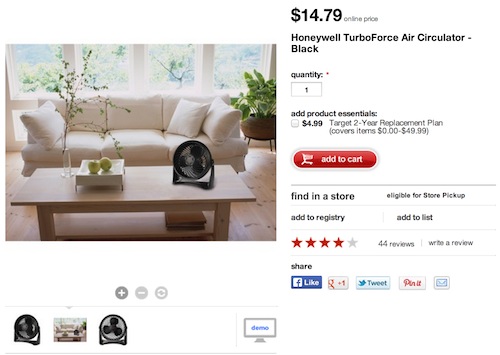
Its a hot summer afternoon. Imagine being cooled by this fan! I can.
3. Use Product Videos
Videos help sell. If you have a short video clip of how to use your product, consider using that clip on your Instagram profile. Here are some great tools for creating a simple social media video that can be used to demo products. Product videos do not have to be super high production quality videos to be successful. There is a certain level of authenticity from having a less highly produced video. Test to see what is most effective with your audience. Gap has good examples of product videos that may generate some ideas.
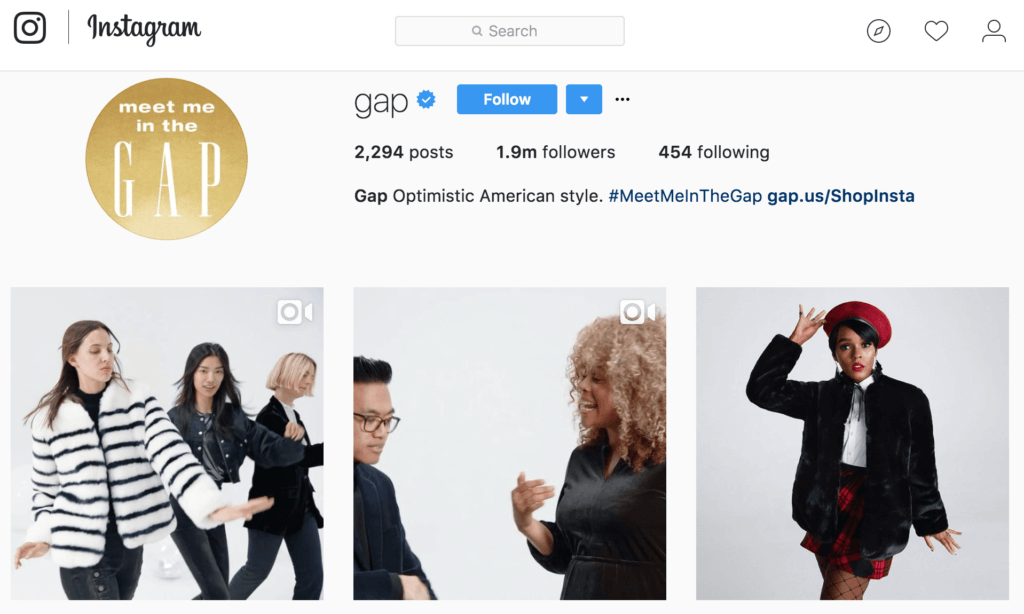
4. Get More Fans with Sharing Buttons
Getting your products shared is an important part of increasing your social media exposure and improving organic search performance. There is growing evidence that social discovery is as important as showing up in organic search engine results. Pinterest, for example, generates roughly $0.78 in new business for every pin. Social media tools are free just like Google organic search results and provide a diversified source of visitors. The opportunity to generate positive ROI from social sharing is real. There is also growing evidence that social media signals are impacting organic search engine indexing. Websites with few social media signals are losing out to sites with a strong social presence due to the links social exposure helps create. Social proof is an important factor in how many additional shares and links your pages receive, which help improve your SEO performance. Use social media to attract more fans for your fans! (sorry for the puns)
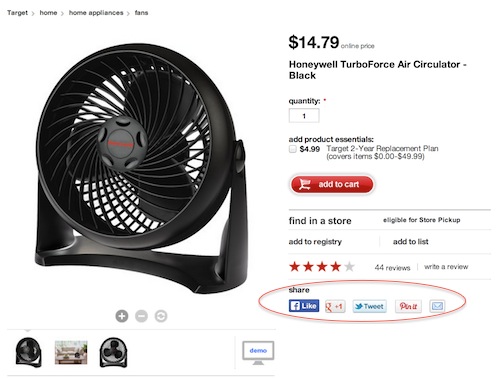
5. Be Real, Don’t Oversell
When describing your products, don’t oversell. Banging pots and pans will make a lot of noise but its not a good way to attract customers. While you may take pride in your business and think your product is the best on the market, avoid tooting your own horn. If the product has merit and it’s well reviewed by customers, the product will do well on its own merit. Making too many promises in your product description is a sure way to repel buyers. You could spend hours and wasted money on trying to figure out what’s wrong with your SEO or social media program, just to find out your copy is killing your sales. When engaging customers in social media, try not to push your agenda. Give your customers valuable content and they will advocate your brand. Don’t be afraid to open up reviews on your products. Customer reviews can help uncover issues in your products and provide a forum for customer service.
6. Add Product Reviews
When you see product reviews on an ecommerce site, thats an example of “user generated content”. Whether you allow your customers to add reviews to products or pull reviews from an API, user generated content can be great way to improve sales. Since content is important to search engines, reviews will help create more search friendly content. Make sure you engage your reviewers and monitor feedback. Feedback can be very useful to improve products and aid customer service. FAQ pages can be generated from customer reviews, which help add more search engine optimized content in your customer’s own language.

7. Rich Snippets & Google AMP
Giving your products Schema.org tags can add additional product information in organic search results. Product reviews and brands become part of your organic listings. If you host your own videos, you can also get rich video snippets to show up in organic results. Many of the rich snippet results will generally ranking higher than normal organic results.
Adding Google AMP is another great way to improve your pages in Google’s mobile search results. AMP takes normal web page content and reformats the content exclusively for mobile search. AMP pages are growing in organic search and seem like an easy win for most businesses.
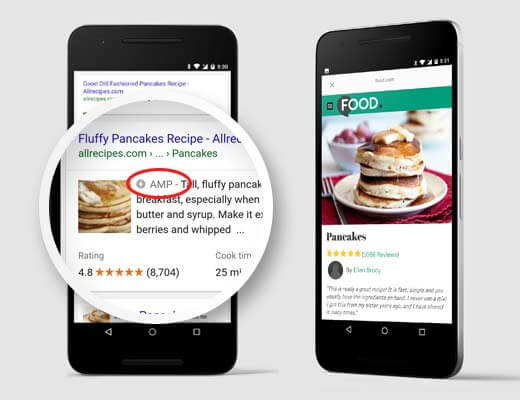
8. Use a CDN
If you’re serving up your own product videos and lots of images, consider using a content delivery network to offload some of that bandwidth to a dedicated service. Using a CDN can speed up your site significantly and help improve your organic placement. Bootstrap CDN and Max CDN are just a few examples of services to help you speed up your site.
Not sure if your site uses a CDN or needs speed improvement? Google provides a nice site speed tool to find out. Simply offloading some of your resources like PDF downloads, videos, or product detail images can help improve your customer experience.
9. Don’t Over Optimize
The temptation when optimizing your products is to stuff the product title, description and copy with keywords. Avoid using too many keywords. Try optimizing your categories and product listings with just one or two main keywords, this will prevent your listings from appearing like spam. Shorter and more concise descriptions tend to outperform over optimized sites. Think about our earlier recommendation on semantic search copy. Write copy that includes many variations of ways people describe your products, and try to avoid using the exact phrase too often.
10. Have an Advertising Budget
My final and most important tip is to advertise. Pay-per-click text ads have been around since the early days of Google and are still effective. Bing product ads and Google shopping ads are relatively new to search results. Both product ads and text ads take up valuable real estate in search results. On mobile devices, the number of organic results becomes even smaller. If your competitors are listed in those positions, you are potentially losing market share to those listings. Make sure you have a budget set aside for paid media advertising. Relying 100% on organic clicks is not a good strategy.
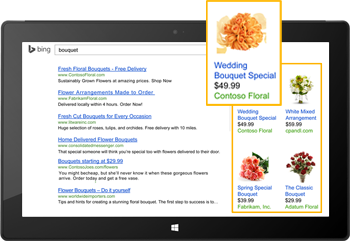
11. BONUS – Use Social Advertising
Social media advertising is becoming a bigger part of a marketers tool set. Reaching customers through organic search alone is not a sustainable way to grow business. Companies must have an integrated approach to reaching customers that crosses both media channels and devices. Think beyond SEO and think beyond your website.
Please Share
We hope you have enjoyed these marketing tips. If you feel the information was helpful in any way, please share on Facebook, Linkedin, Twitter, or Google+.
photo credit: jgrimm Parking Lot changed color (license)
